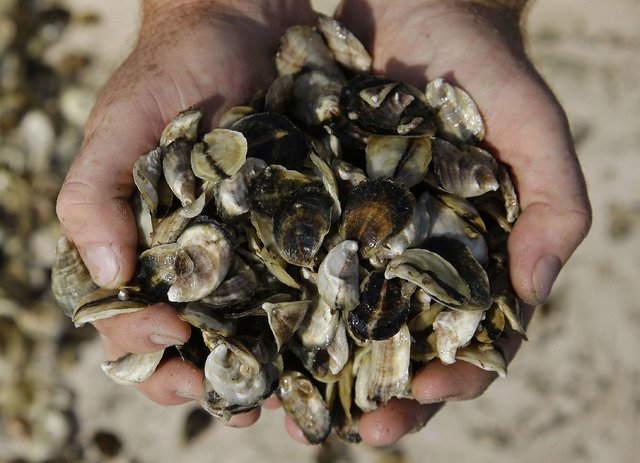Study links global warming to rise in waterborne illnesses

ASSOCIATED PRESS
An oyster cultivator held oyster seed before spreading it into the waters of Duxbury Bay in Duxbury, Mass. in Sept. 2013. A study published today connected rising temperatures to increasing rates of several waterborne diseases. About a dozen species of vibrio bacteria make people sick from eating raw or undercooked seafood, particularly oysters, or drinking or swimming in tainted water.
WASHINGTON » Rising global temperatures are clearly linked to increasing waterborne food poisoning, particularly from eating raw oysters, along with other nasty infections, a new study shows.
About a dozen species of vibrio bacteria make people sick from eating raw or undercooked seafood or drinking or swimming in tainted water. It also causes cholera, although that was not the focus of the research.
Lab-confirmed vibrio infections in the United States have increased from an average of about 390 a year from the late 1990s to an average of 1,030 in recent years, according to the Centers for Disease Control and Prevention. But most cases aren’t confirmed by tests and reported.
“It’s a remarkable increase on an annual basis,” said study lead author Rita Colwell of the University of Maryland, a top microbiologist who used to head the National Science Foundation.
The study examined Europe and North America, but the most consistent tracking of vibrio illnesses were in the United States. The CDC blames about 100 deaths a year on vibrio on average.
Even Alaska, where such outbreaks used to be unheard of because the bacteria needs warm water, is getting cases from people eating vibrio-infected oysters, Colwell said. Her study, published in Monday’s Proceedings of the National Academy of Sciences , highlights an unprecedented wave of vibrio illnesses from swimming in northern Europe during heat waves in 1994, 1997, 2003, 2006 and 2010.
Don't miss out on what's happening!
Stay in touch with breaking news, as it happens, conveniently in your email inbox. It's FREE!
Until now, researchers had indirectly linked climate change to an increase in illnesses from the bacteria, Colwell said. Using DNA, a 50-year database of plankton, water temperatures and disease reports, she shows a more comprehensive connection.
“Now we have linked very directly the increase and the trend in number of cases, so it’s all coming together in great detail,” Colwell said.
With the giant database of plankton and DNA, the international team of scientists was able to monitor how pervasive the vibrio bacteria have become in waterways around the world by creating an index. The index doesn’t show the number of vibrio, but its relative abundance, said study author Luigi Vezzulli of the University of Genoa. That index has about tripled in many of the areas they examined, including the North Atlantic.
That type of examination of vibrio levels in plankton hasn’t been done before and “is critical to understand the regional scale of changes in climate to potential increases in human risk,” said Erin Lipp, a University of Georgia, professor of environmental health sciences. She wasn’t part of the study but praised it as exciting and important.
Online:
3 responses to “Study links global warming to rise in waterborne illnesses”
Leave a Reply
You must be logged in to post a comment.




But most cases aren’t confirmed by tests and reported…highlights an unprecedented wave of vibrio illnesses from swimming in northern Europe during heat waves in 1994, 1997, 2003, 2006 and 2010.
While it’s reasonable to infer that warmer water temperatures raise some bacteria levels, the increase “…from an average of about 390 a year from the late 1990s to an average of 1,030 in recent years…” could well be a result of greater compliance in reporting during that period. I’ve had food poisoning from seafood in the past, but I never saw a doctor about it, and, for those who do, how often do their physicians inform the CDC? I’d guess a lot more now than 20 years ago.
That’s the problem with a lot of these less than rigorous “studies”. When our state climatologist asserts that average temperatures over the last 100 years in Hawaii have increased, how many monitoring stations with properly calibrated equipment even existed a century ago compared to today?
They’re out to get us.
Who the oysters?